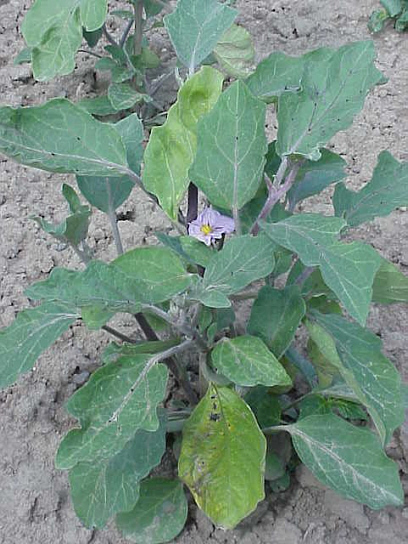

Zitierweise / cite as:
Carakasaṃhitā: Ausgewählte Texte aus der Carakasaṃhitā / übersetzt und erläutert von Alois Payer <1944 - >. -- Anhang A: Pflanzenbeschreibungen. -- Solanum melongena L. -- Fassung vom 2007-07-26. -- URL: http://www.payer.de/ayurveda/pflanzen/solanum_melongena.htm
Erstmals publiziert:
Überarbeitungen:
Anlass: Lehrveranstaltung SS 2007
©opyright: Dieser Text steht der Allgemeinheit zur Verfügung. Eine Verwertung in Publikationen, die über übliche Zitate hinausgeht, bedarf der ausdrücklichen Genehmigung des Verfassers
Dieser Text ist Teil der Abteilung Sanskrit von Tüpfli's Global Village Library
WARNUNG: dies ist der Versuch einer
Übersetzung und Interpretation eines altindischen Textes. Es ist keine
medizinische Anleitung. Vor dem Gebrauch aller hier genannten Heilmittel wird
darum ausdrücklich gewarnt. Nur ein erfahrener, gut ausgebildeter ayurvedischer
Arzt kann Verschreibungen und Behandlungen machen!
Falls Sie die diakritischen Zeichen nicht dargestellt bekommen, installieren Sie eine Schrift mit Diakritika wie z.B. Tahoma.
Verwendete und zitierte Werke siehe: http://www.payer.de/ayurveda/caraka0001.htm

Abb.: Solanum melongena L.
= Aubergine
[Bildquelle: Wikipedia]
Drury:
"Solanum melongena (Linn.) Do. The Brinjal or Egg-plant, Eng. Valoothala, Mal. Valoothalay, Tam. Wankai, Tel.
Description.—Perennial; stem clothed with stellate tomentum; leaves ovate, unequal at the base, angularly sinuated, downy; flowering peduncles solitary, reflexed; calyx prickly, campanulate; segments linear-lanceolate; corolla violaceous, 6-9 cleft, marked by a yellow star inside; fruit oval, smooth. Fl. Nearly all the year.
The varieties are—
- Stem, leaves, and calyxes unarmed or nearly so. Solanum ovigerum, Dun. Rom. and Sch.—S. Melongena, Linn. Willd. Roxb. Fl. Ind. i. 566, Beng.—Brinjal, Egg-plant, Eng.—Bangan, Hind.—Wankai, Tel.-------All over India. Fl. largish, violet.
- Stem, leaves, and calyxes more or less aculeate. Solanum esculentum, Dun. — S. Melongena, Linn, suppl.— S. insanum, Linn. Willd. (not Roxb.)—S. longum, Roxb. Fl. Ind. i. 567.—Neelavaloothana, Rheede, x. t. 74.— Kooli-begoon, Beng.—Long Brinjal. Fl. largish, bright bluish purple.
The fruit of each of these varieties is either ovate-oblong or oblong, violet or white; or globular (larger and smaller), violet; or more and less globular, white, or white-striped on a violet ground.
Economic Uses.—The Brinjal is universally cultivated in India as an esculent vegetable, belonging to an order of plants remarkable for their poisonous as well as harmless qualities. On this subject Dr Lindley has well remarked : " The leaves of all are narcotic and exciting, but in different degrees,—from the Atropa Belladonna, which causes vertigo, convulsions, and vomiting—the well-known Tobacco, which will frequently produce the first and last of these symptoms—the Henbane, and Stramonium, down to some of the Solanum tribe, the leaves of which are used as kitchen herbs. It is in the fruit that the greatest diversity of character exists. Atropa Belladonna, Solanum nigrum, and others, are highly dangerous poisons; Stramonium, Henbane, and Physalis are narcotic ; the fruit of Physalis Alkekengi is diuretic, that of Capsicum is pungent, and oven acrid ; some species of Physalis are sub-acid, and so wholesome as to be eaten with impunity (e. g., the well-known Tepariga); and finally, the Egg-plant (Solanum Melongena, Brinjal), and all the Tomato tribe of Solanum, yield fruits which are common articles of cookery. It is stated that the poisonous species derive their properties from the presence of a pulpy matter which surrounds the seeds; and that the wholesome kinds are destitute of this, the pulp consisting only of what botanists call the sarcocarp—that is to say, the centre of the rind, in a more or less succulent state. It must also be remembered that if the fruit of the Egg-plant is eatable, it only becomes so after undergoing a peculiar process, by which all its bitter acrid matter is removed, and that the Tomato is always exposed to heat before it is eaten."
[Quelle: Drury, Heber <1819 - 1872>: The useful plants of India : with notices of their chief value in commerce, medicine, and the arts. -- 2d ed. with additions and corrections. London : Allen, 1873. -- xvi, 512 p. ; 22 cm. -- s.v.]